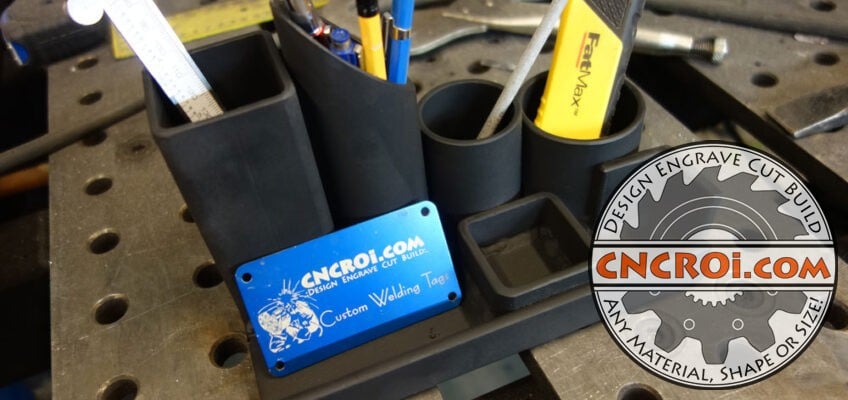Welded Scrap Metal Desktop Organizer: FCAW & E7014
Let’s turn a pile of stuff into a welded scrap metal desktop organizer using FCAW and SMAW using E7014 at CNCROi.com.
At CNCROi.com, we’re always looking for ways to turn leftover scrap into functional, meaningful projects. This time around, I decided to tackle a custom desktop organizer made entirely from scrap metal sitting around the shop.
Over time, running CNC plasma cutting jobs and fabricating custom parts results in an inevitable accumulation of offcuts—little bits of tubing, plate, angles, and more. While some see scrap, we see opportunity.
Every fabricator knows the irony: the moment you get rid of a piece you’ve held onto for years, you suddenly need it for a last-minute customer order. Instead of buying 7.3 meters (24 feet) of tubing to get 76 mm (3 inches), it makes far more sense to plan and weld something useful from what’s on hand.
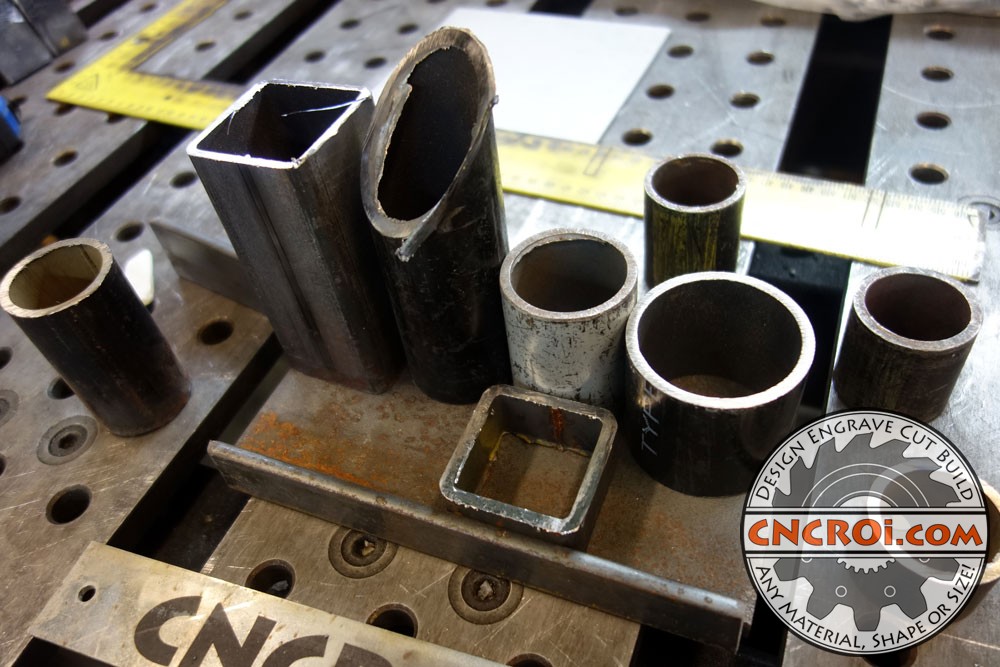
This project involved welding random tubing sections into a unique and robust welded scrap metal desktop organizer, one that would easily withstand day-to-day use.
The materials were completely mismatched, varying in wall thickness, finish, and composition. That said, their differences became a design advantage rather than a flaw. This wasn’t going to be a display piece—it needed to be functional, solid, and good-looking after a fresh coat of paint.
I decided to go with flux-cored arc welding (FCAW) for the tack welds because it’s fast and effective, but for the final passes, I used 7014 welding rods, 1/8″ (3.2 mm) in diameter, run at 120 amps. 7018 rods are only mentioned here for comparison and educational purposes during the build process of the welded scrap metal desktop organizer.
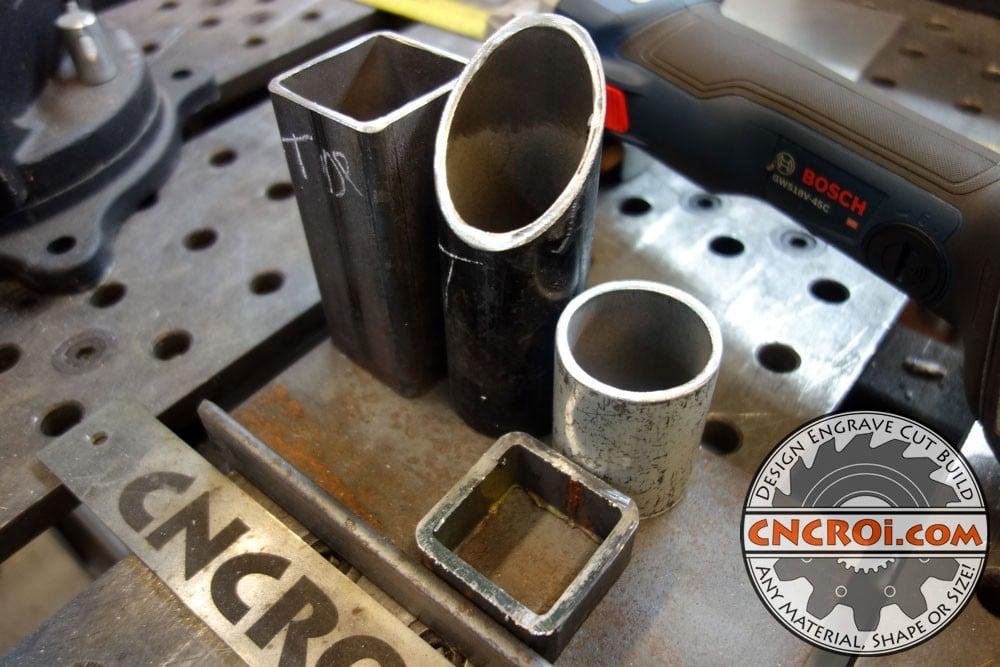
The initial stage of this custom fabrication job began by digging through the scrap pile and dry fitting different tubing pieces. This is a crucial step for any custom welding or CNC fabrication job.
Even when material is free, time isn’t, and poor planning leads to time-consuming rework. The dry fit process took longer than expected, as I had to ensure each joint fit tight, the organizer would stand level, and the overall form remained aesthetically pleasing.
Once I had the general layout for the welded scrap metal desktop organizer at CNCROi.com, I moved on to prepping each piece.
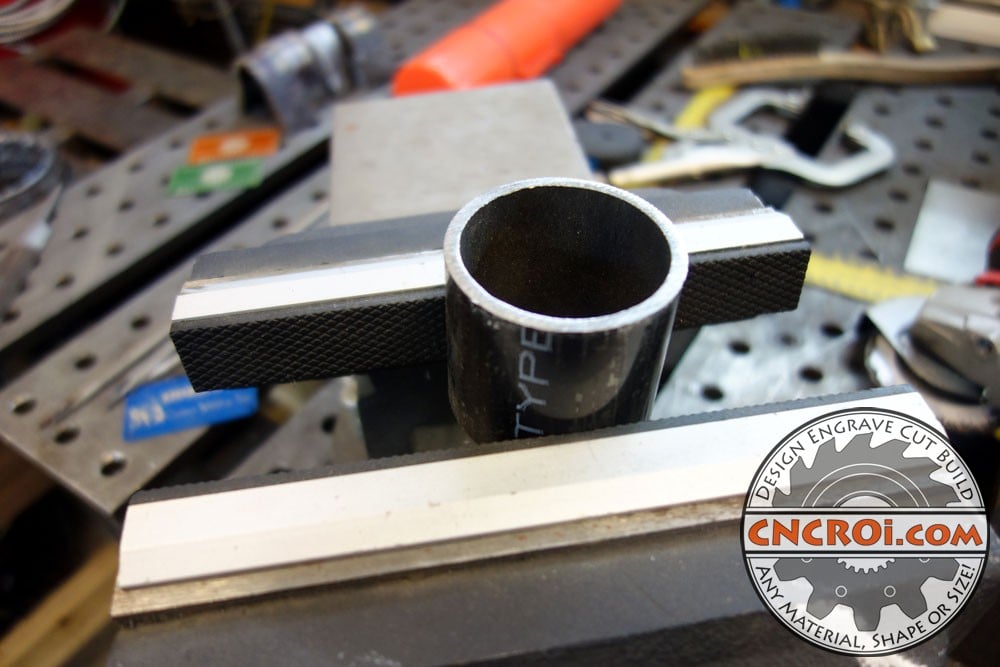
Surface preparation plays a vital role in welding, whether you’re dealing with mild steel, stainless, or aluminum.
For this build, I used both an angle grinder with a flap disc and a hand file to clean the weld zones. Removing paint, rust, mill scale, and burrs ensures better penetration and a cleaner weld pool.
Since welding involves closing an electrical circuit, contaminants like paint and debris interfere with arc stability and fusion. Clean metal means cleaner, stronger welds. The flap disc almost felt like sculpting metal—gritty but satisfying.
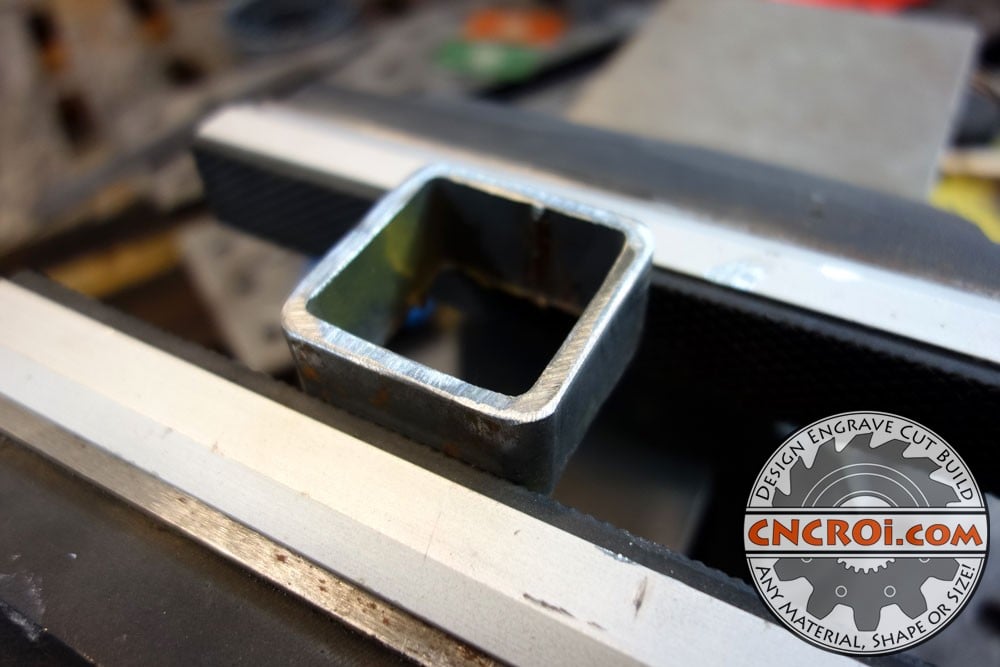
After grinding and filing, I placed the cleaned pieces into the sandblaster. I used glass beads at 120 PSI (8.3 bar), which not only cleaned the metal further but also provided an ideal texture for paint adhesion later on to build the finished welded scrap metal desktop organizer at CNCROi.com.
Glass bead blasting softens the surface visually without compromising strength, leaving a uniform matte finish. Any hidden debris or stubborn paint layers that survived the flap disc were blasted away efficiently.
I made sure to target corners and tight gaps that a grinder couldn’t reach, ensuring everything was as clean and consistent as possible.
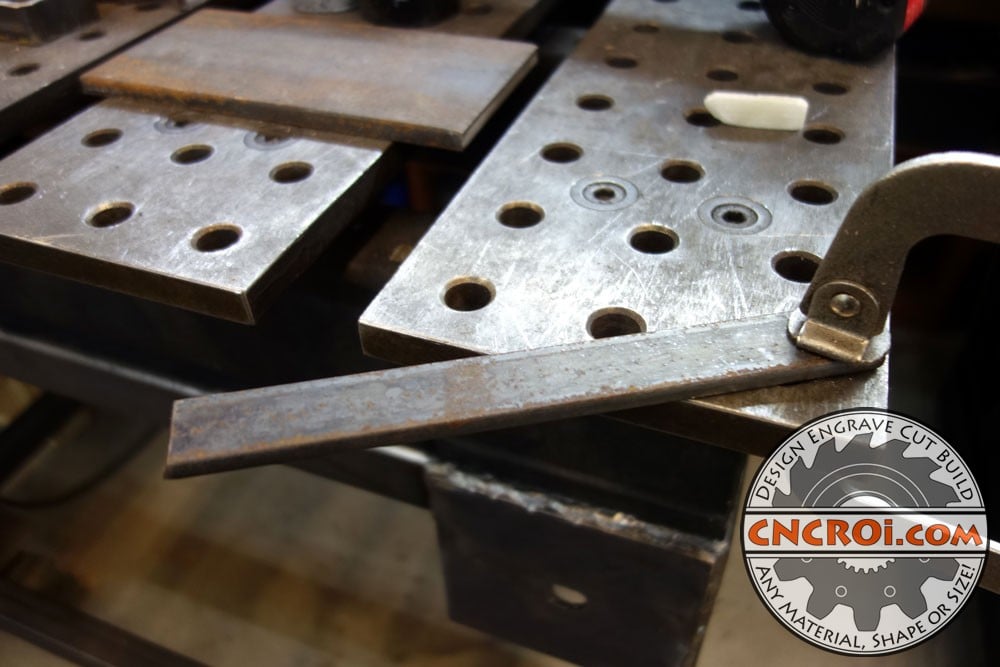
Redoing welds or grinding deep into a finished joint can compromise integrity. This is where experience at CNCROi.com really comes into play—knowing where problems will show up later, and eliminating them before they happen.
Prepping once, properly, saves hours, the above towel holder taught me a lot about that, though I knew just about nothing regarding welding, if I would have known to prep it a bit more before doing so, the resuls wouldn’t have been so challenging.
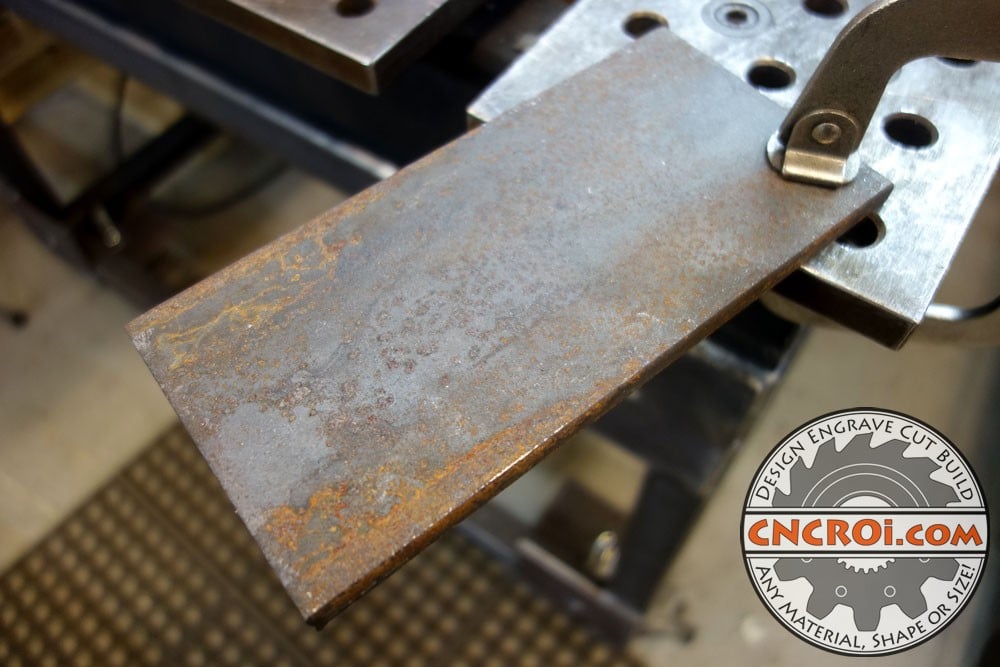
With the metal fully prepped, I started tack welding the frame using flux-cored arc welding (FCAW) at CNCROi.com for the welded scrap metal desktop organizer build. This method is especially helpful when you’re holding oddly shaped pieces together by hand.
The wire feed is continuous and runs hotter than MIG, which gives deeper penetration on thicker materials. Once I had the shape fully tack-welded, I switched to 7014 rods, run at 120 amps, to finish the job.
This rod is great for beginners and seasoned welders alike because it’s self-cleaning and produces attractive welds with minimal effort. It’s also perfect for static loads, like this desktop organizer, which won’t experience vibration or temperature fluctuations.
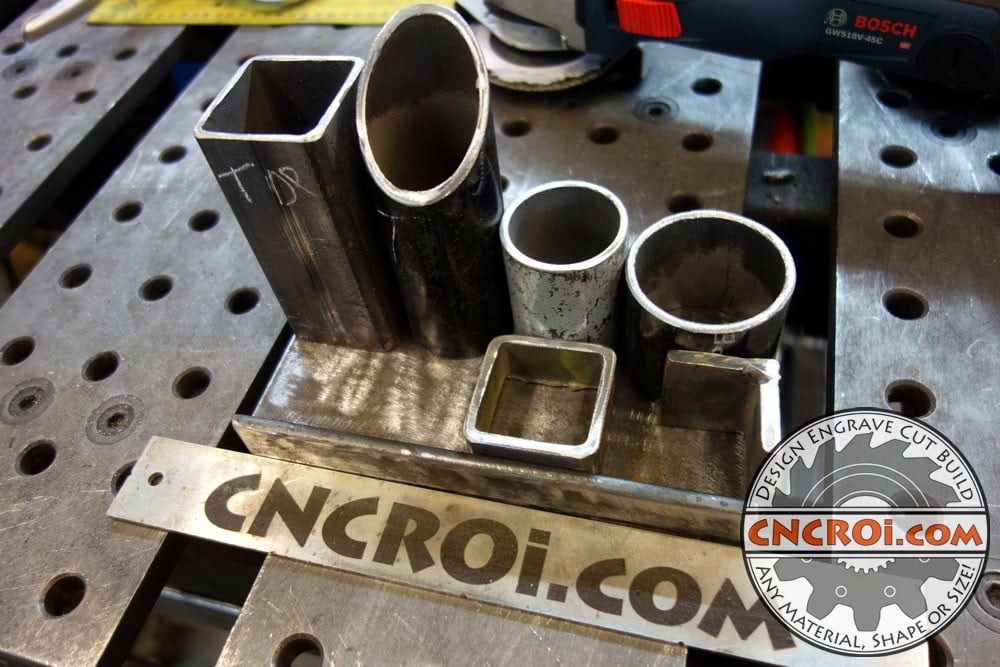
Now, while 7018 rods are ideal for high-stress, dynamic load applications like bridges or high-temperature zones, they require a rod oven to prevent moisture contamination. I didn’t need that complexity for the welded scrap metal desktop organizer.
7014 rods, often called “drag rods,” are much easier to work with for general fabrication. They start easily, tolerate light surface oxidation, and don’t demand special storage. That makes them a go-to for small custom fabrication jobs like this. Plus, they produce a strong weld and a smooth bead appearance with minimal spatter.
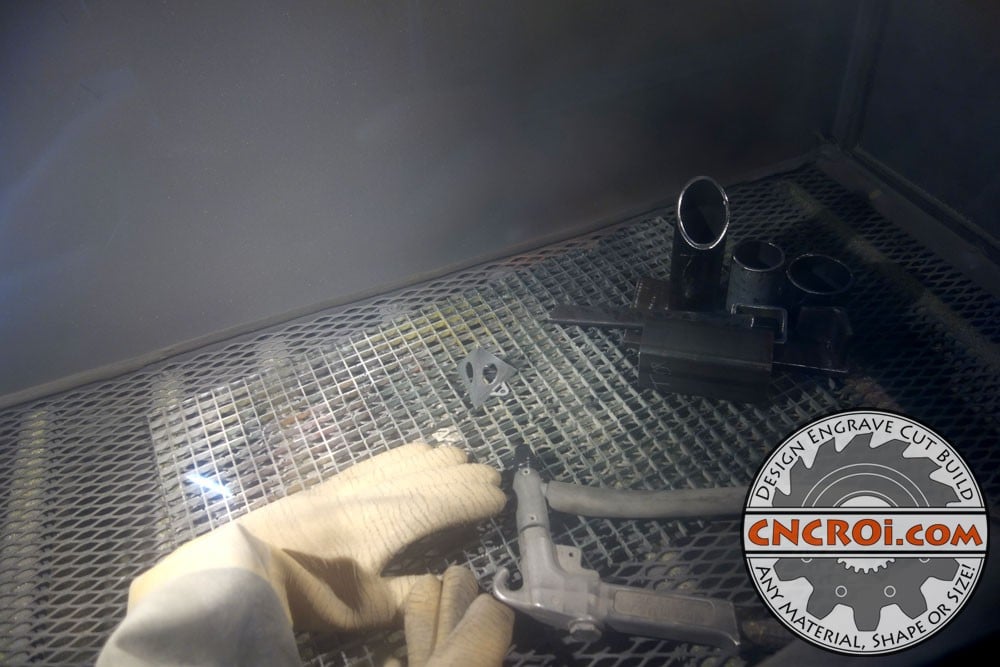
Although 7014 rods don’t have the same low-hydrogen properties as 7018s, they’re perfect for shop builds where environmental conditions aren’t tightly controlled. They’re also very forgiving in terms of rod angle, travel speed, and starting technique, which is why I often recommend them to people just getting into arc welding.
In my case, I actually learned the hard way—starting with 7018s during college—but having that foundation helped me appreciate the more user-friendly nature of 7014s even more.
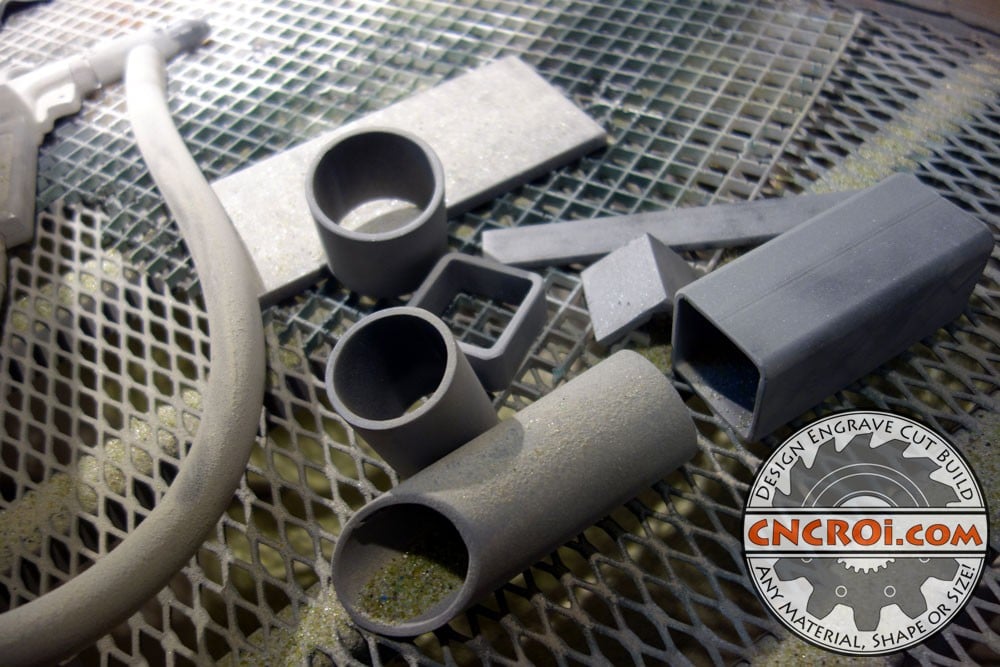
I made sure to clean each weld joint twice before running any arcs. First, I used shop towels to wipe off dust generated during bead blasting. Glass bead residue creates a fine powder, which can interfere with arc stability and adhesion during painting.
After wiping down the surfaces of the welded scrap metal desktop organizer at CNCROi.com. I followed up with acetone to remove oils or residues that could compromise the weld. Once cleaned, I let everything dry thoroughly before beginning to tack and weld.
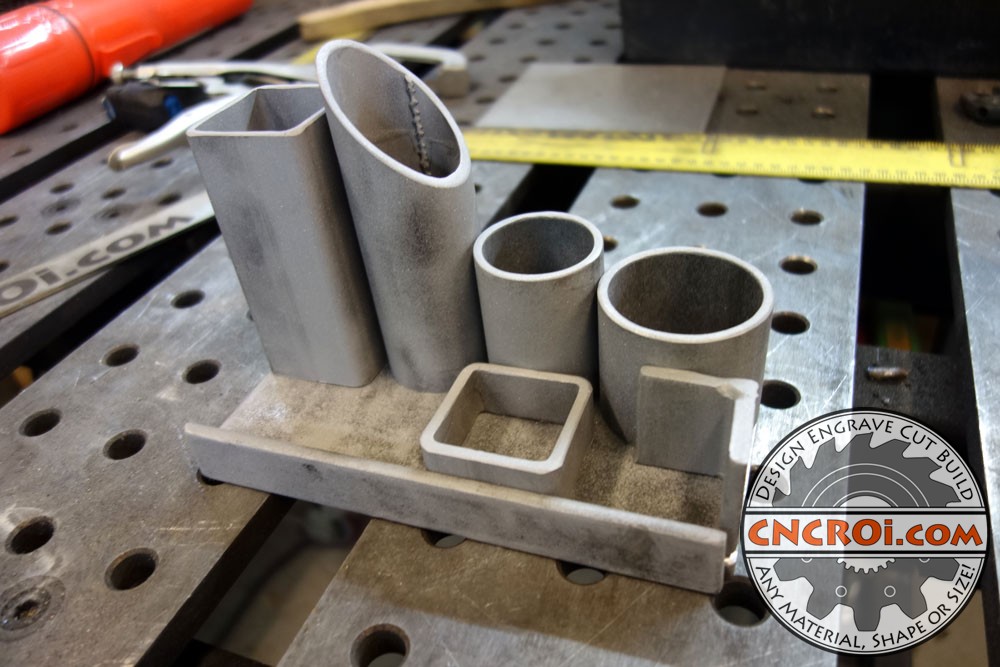
Looking back, one mistake I made was only tack welding as I progressed, rather than fully welding around each joint while I still had easy access. I should have used a smaller diameter rod in tight spots or done full perimeter welds on accessible areas first. That would have made finishing later stages easier and more consistent.
Access became a challenge in certain zones, especially as the piece became more rigid. Next time, I’ll remember that even the welded scrap metal desktop organizer benefit from a strategic weld sequence.
That’s the nice thing about welding tags, they are generally in an easily accessible area with high visiblity for repeat business.
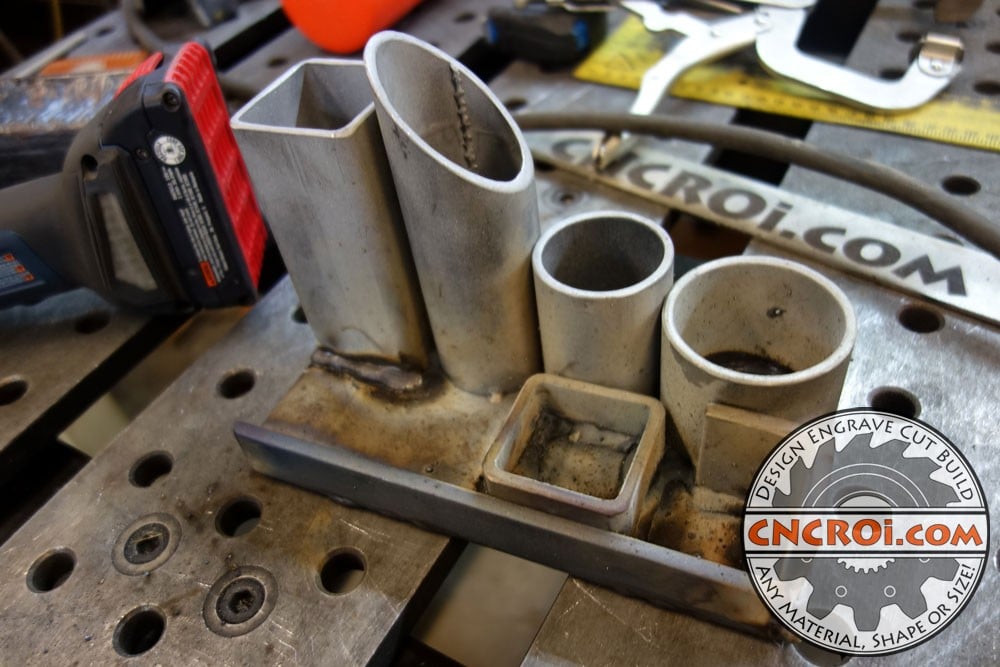
Despite these limitations, the 7014 rods worked incredibly well. Their arc stability, smooth travel, and slag coverage made the job easier, especially considering some parts were out-of-position.
I didn’t use a rod oven since I wasn’t running 7018s, which kept setup simple. Gravity helped in flat positions, so whenever possible, I oriented parts to take full advantage of natural force instead of fighting it.
Welding horizontally or in the flat position also reduces porosity and improves bead quality.
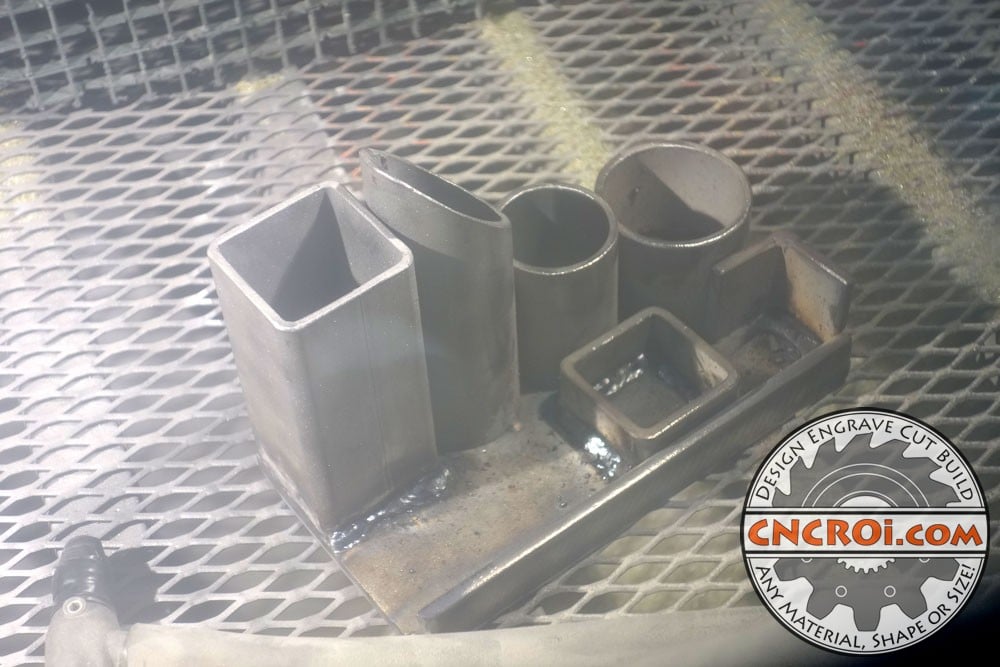
After finishing the welds, I returned to the angle grinder to clean up slag and refine some of the beads. Some areas were difficult to access with a chipping hammer, so I tossed the frame back into the sandblaster.
One lesson learned here: glass bead blasting isn’t ideal for removing heavy slag. It works well for dust and minor surface cleanup, but if you’ve got leftover flux that didn’t pop off cleanly, it’ll take extra work or a change in media—perhaps aluminum oxide or steel grit if needed.
In this case, I got it done with glass beads, but it wasn’t the fastest solution for clean-up of the welded scrap metal desktop organizer at CNCROi.com.
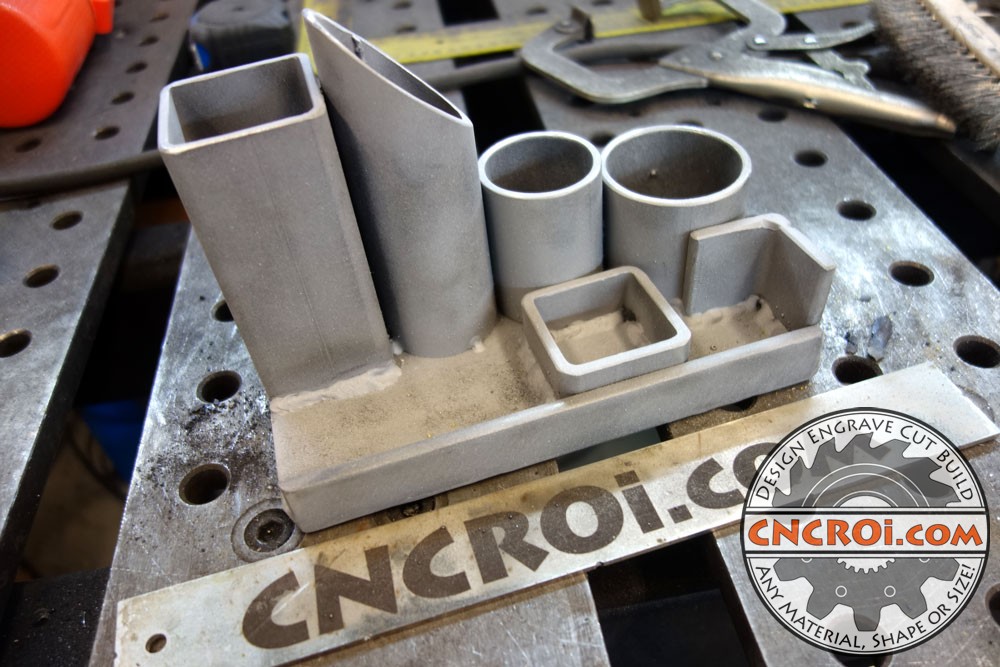
As with many projects at CNCROi.com, this build taught me new tricks while reinforcing old ones. The finished organizer weighs about 5 lbs (2.27 kg) and has a solid feel. That weight gives it a quality that mass-produced plastic versions simply can’t match.
I don’t typically have to deal with tight spaces with my projects thus far and the weld sequence isn’t so vital but each project has it’s lessons.
The only real issue came from welding in tight spaces where my rod angle wasn’t optimal. I couldn’t rotate the workpiece once it was partly built, which created a challenge for internal welds. More modular welding could have solved that.
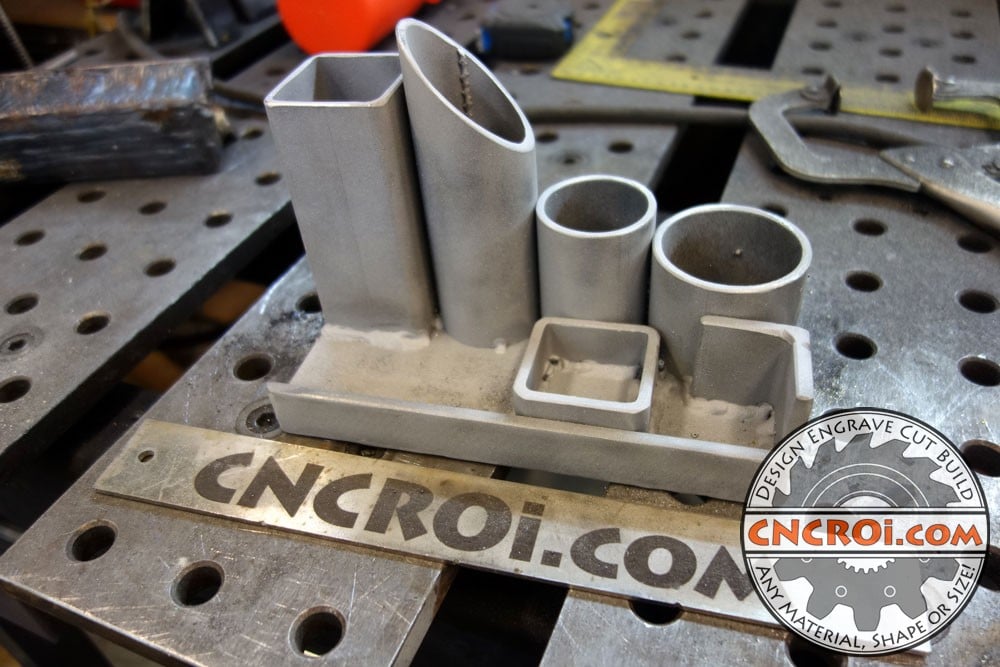
Once finished, I gave the entire organizer a final cleaning and applied paint. Here’s where the surface prep really paid off. The sandblasted texture provided a uniform surface that helped the paint bond evenly and dry smoothly.
One pleasant side effect of paint is that it hides minor imperfections present on this welded scrap metal desktop organizer, like traces of slag or undercut. This isn’t a structural weld going into space—it’s a shop tool. Paint helps unify the design visually and adds a layer of corrosion resistance too.
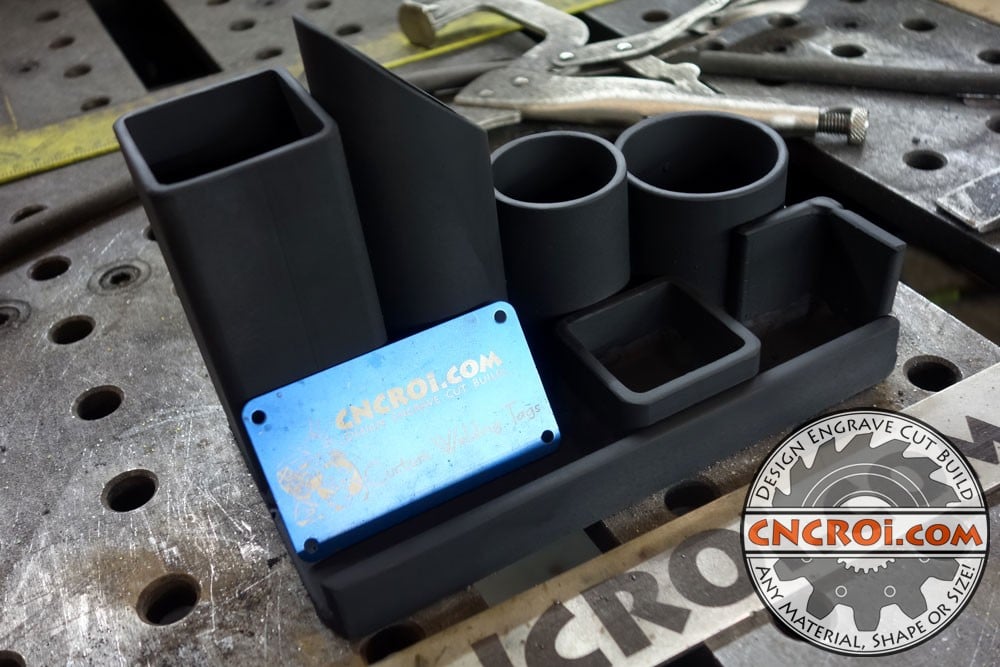
All in all, this project was a great example of why it pays to understand both your tools and your materials. From the dry fit to the final pass, it was a rewarding challenge in small-scale custom fabrication.
Using 7014 rods exclusively at 120 amps proved the right choice for this static-load application. The rods were affordable, easy to work with, and produced great results.
Most of the projects I do at CNCROi.com involve 7018 electrode so it was a nice change to try something a little different, each rod really acts differently but same in some ways… that’s the fun of welding!
I also learned to better sequence my welds and prioritize accessibility in tight spaces—a valuable lesson for future builds.
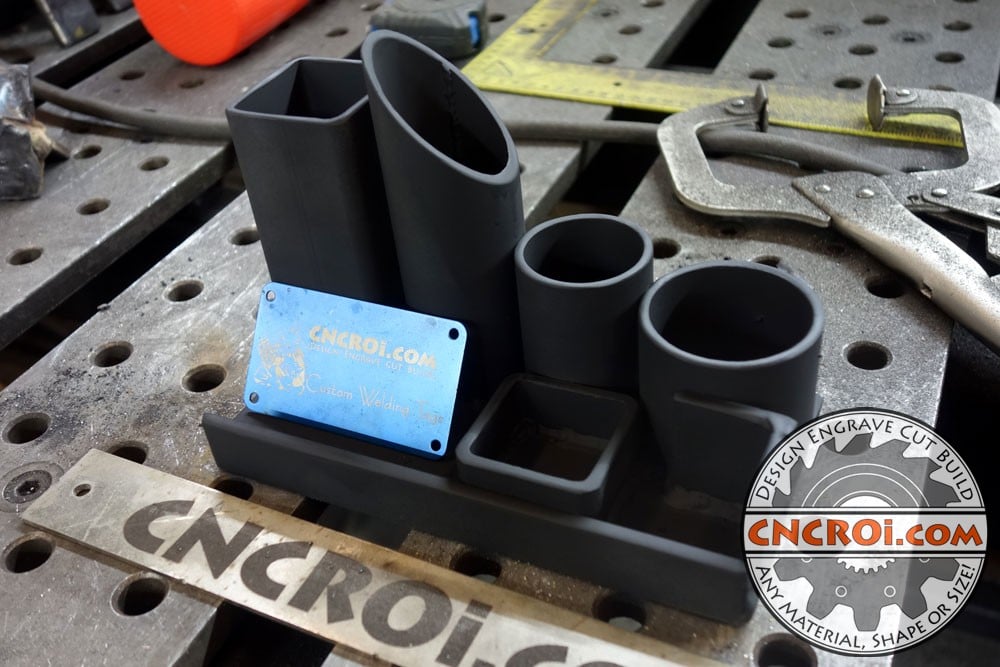
If you’re looking for custom welded fabrications using CNC equipment and shop expertise, CNCROi.com is your go-to solution. We specialize in turning ideas into physical products—whether that’s large signage, metal branding irons, or functional pieces like this organizer. Every project is unique, and we treat it that way.
We can weld, cut, engrave, and machine nearly any material, and we ship globally. No job is too small or too weird. If it can be made, we’ll find a way to make it.
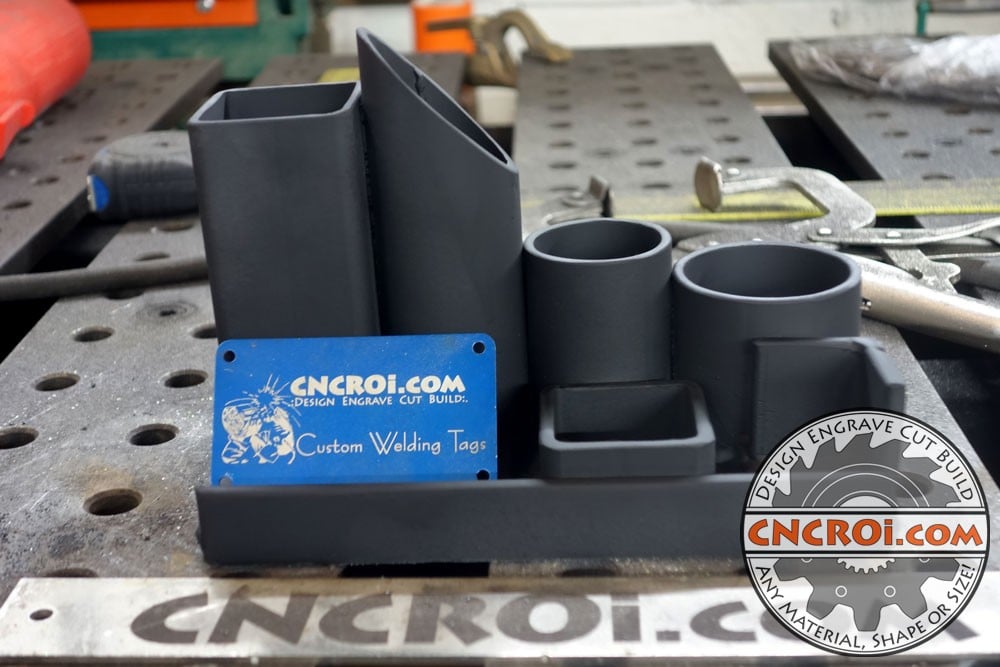
That’s the beauty of working in a shop that combines CNC precision with manual welding know-how. You’re not limited to templates or mass production runs. You can make exactly what you want, to fit exactly how you need it. Custom fabrication is about solving problems and making something that’s truly yours.
Whether it’s a desktop organizer made from offcuts or a massive sculpture, the tools and principles are the same. Prep well, weld clean, and finish with care.
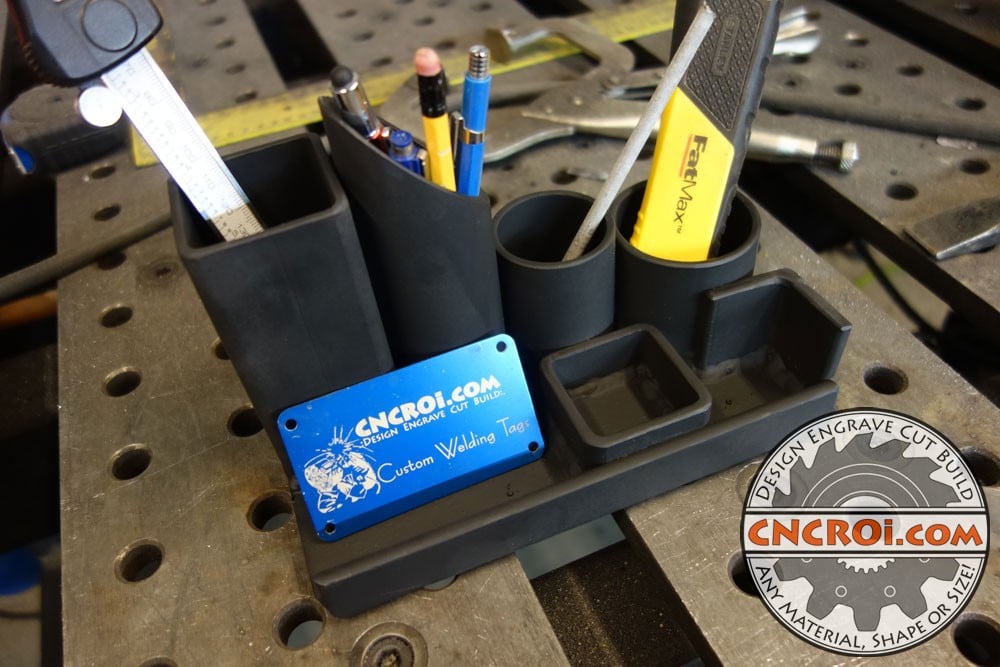
And remember: that scrap you were about to toss? It might just be your next great build. Contact CNCROi.com right now if you have a project in mind that we can help you with.
